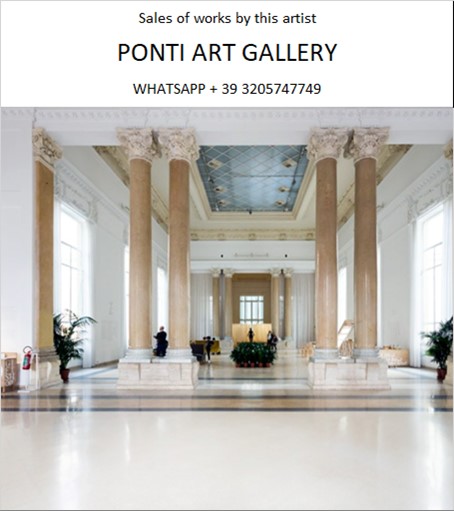Ponti Art Gallery is interested in buying and selling works
of art by this artist.

Anton Rooskens Biography
Anton Rooskens, born on March 16, 1906, in Griendtsveen, Netherlands, emerged as a significant figure in the post-war European art scene, particularly known for his contributions to the COBRA movement. His journey into the realms of art was not through traditional channels; rather, it was marked by a series of self-taught explorations and a profound engagement with the cultural and artistic expressions beyond the European tradition.
Rooskens' early life in the Netherlands was characterized by a modest upbringing. Despite attending the Venlo Technical School from 1924 to 1934, where he was exposed to the basics of technical drawing and possibly metalworking, Rooskens did not pursue a formal education in fine arts. This lack of conventional artistic training did not deter him; instead, it propelled him towards a path of self-discovery and experimentation in the arts. By 1935, Rooskens had moved to Amsterdam, a city that would become central to his artistic development. Here, he took up a teaching position in metalworking and industrial design at the Don Boscoschool, a role that likely provided him with a stable income while he continued to explore his artistic inclinations.
The transformative phase in Rooskens' artistic journey began in the late 1940s, particularly around 1948, when he became associated with the COBRA group. COBRA, an acronym for Copenhagen, Brussels, and Amsterdam, was a collective of avant-garde artists who sought to break away from the prevailing artistic conventions of the time. They advocated for a spontaneous and experimental approach to art-making, emphasizing the importance of individual expression and the integration of elements from folk and tribal arts. Rooskens, with his inclination towards African art and non-Western cultural expressions, found a resonance with the COBRA philosophy. His works from this period are characterized by bold, simplified forms, heavy lines, and vibrant fields of color, often employing minimal strokes to convey a sense of dynamism and spontaneity.
In 1954, Rooskens briefly experimented with a geometric style, heavily influenced by African art. This phase marked a departure from his earlier, more fluid forms, showcasing his versatility and willingness to explore different artistic languages. However, by 1956, he had returned to a more abstract expression, incorporating dynamically executed abstract signs into his compositions. This period is noted for Rooskens' development of a personal visual language, filled with magical signs and symbols rendered in a palette of black, yellow, ochre, blue, and red. These works are not just abstract compositions; they are imbued with a sense of mysticism and a deep connection to the primal forces of nature and humanity.
Throughout his career, Rooskens maintained a belief in the primacy of spontaneous creation, a principle that aligned with the broader COBRA ethos. According to many COBRA painters, the act of creating was more important than the final result, a philosophy that Rooskens embraced wholeheartedly. His approach to painting was free and uninhibited, allowing him to express his innermost emotions and thoughts through a vibrant and expressive visual language.
Anton Rooskens passed away in 1976, leaving behind a rich legacy that continues to inspire and influence artists and art enthusiasts alike. His work, deeply rooted in a quest for universal expression and a profound appreciation for the artistic traditions of non-Western cultures, stands as a testament to the power of art as a medium of cross-cultural dialogue and personal exploration. Rooskens' contributions to the COBRA movement and his unique artistic vision have cemented his place as a pivotal figure in the history of 20th-century European art.
Anton Rooskens Quotes and
Sales of Works
Ponti Art Gallery selects and deals with paintings by the
artist. Upon request, we provide free estimates and
evaluations, communicate prices, quotations, and current
market values.
If you are interested in BUYING or SELLING works by the
artist, contact us immediately.
If you wish to sell or receive an evaluation of the
works:
Send us a frontal photo of the painting, one of the back,
and one of the signature. Also, indicate the dimensions of
the work. Inform us about the purchase origin of the work
and any kind of available documentation (purchase
receipts, certificates of authenticity, publications). One
of our operators will respond to you on the same day. We
guarantee maximum confidentiality and extreme
professionalism.
If you wish to purchase works by the painter: Contact us
and let us know your request. We will inform you about the
available works. We also offer the possibility to
subscribe to our NEWSLETTER, through which you will be
informed at the beginning of each month about the latest
acquisitions of the art gallery.
You can send us pictures of the work:
